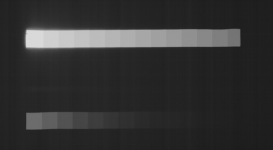philosli
Established
RE: "I assume you made different exposures?"
No it is a single exposure. The target consists of two rows with 14 patches in each row. The difference between the neighboring patches is 1/2 stops. Therefore each row has dynamic range of 7 stops.
Target is transparent and back-illuminated. The exposure was done in dark to minimize veiling glare effect.
This test might be somewhat unfair to film since film's characteristic curve is nonlinear (both in highlights and shadows). Hence I could expose film a bit longer so the highlights get compressed and that should bring more patches from dark.
Any thoughts?
How do you meter?
Films are very tolerant to over-exposure. So I would suggest expose for the shadow, and examine the densities of adjacent patches on the negative to determine its "dynamic" range, not the scanned digital copies on a monitor. Otherwise you might be examining the dynamic range of either your scanner or your monitor.



